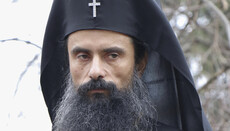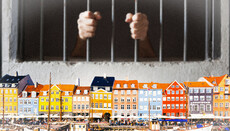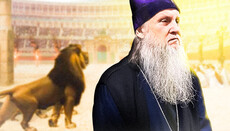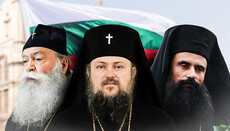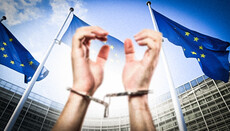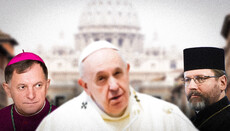Rendezvous in Vatican: Did Shevchuk and Pat. Bartholomew meet by chance?
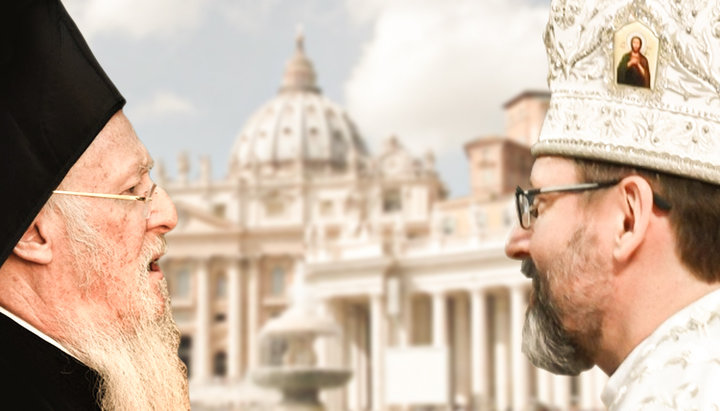
What is behind the statements of the heads of the Phanar and the UGCC on raising the "ecumenical dialogue between the Uniates and the OCU to a new level"?
On September 16, 2019, the Orthodox were excited by the news of the meeting in the Vatican of the head of the Ukrainian Greek Catholic Church Sviatoslav Shevchuk with the Patriarch of Bartholomew of Constantinople. The news is all the more unexpected because since the OCU was created, both Epiphany Dumenko and Sviatoslav Shevchuk have made a number of ambiguous statements, which many were quick to call the beginning of the unification process, in other words – the formation of a new union.
The Church of Constantinople, which, according to the Tomos of the OCU, has the right to control “decisions on important issues of the ecclesiastic, dogmatic and canonical order”, cannot but know of such processes, so the meeting of the heads of the Phanar and the UGCC had to make the point clear in these insinuations : either say their flat “no” or confirm such intentions. The article analyses what this meeting points to.
“Restoration of communion between Rome and Constantinople as the main goal of prayer”
On June 29, 2019, a delegation of the Patriarchate of Constantinople arrived in Rome to take part in the celebration of the feast of the Holy Apostles Peter and Paul. Receiving the delegates, the Pope said: "As the Bishop of Rome, I would like to emphasize once again that for us, Catholics, the goal of the dialogue is complete unity in the permitted differences, not a unifying alignment, much less acquisition."
In turn, the head of the delegation of Constantinople, Archbishop Job (Getcha) of Telmessos, who is considered to be the main expert on Ukraine in the Phanar, assured the Pope that the Patriarchate of Constantinople also seeks to reunite with Rome: “Restoring (Eucharistic – Ed.) communion between our Churches remains our sincere hope, the main object of our prayers and the goal of the dialogue of truth established between our Churches.”
In response to this, the Pope, as a confirmation of his position, presented to the Phanariots part of the relics of St. Peter the Apostle. Archbishop Job called this gift “a prophetic sign of the unity of Rome and Constantinople”, and the Pope in his turn emphasized in a letter to Patriarch Bartholomew that for complete and final unity of Catholics and Orthodox Christians we must act more decisively.
Metropolitan John (Zizioulas), Phanar’s leading theologian, stated back in 2014 that he "sees the basis for "rapid progress" on the path to achieving complete Christian unity under Pope Francis".
And in 2025, a joint celebration of Rome and Constantinople of the 17th anniversary of the First Ecumenical Council is scheduled in Jerusalem. Back in 2014, Patriarch Bartholomew said in an interview with “AsiaNews” that the meeting in 2025, whatever its format is, should mark the horizon in current Orthodox-Catholic relations.
OCU and UGCC – the path to unity?
Recently, there has been a significant increase in talk about the need to unite the OCU and the UGCC. A few days ago, the former President of Ukraine Petro Poroshenko during the celebration of the 50th anniversary of the opening of Santa Sofia a Via Boccea in Rome, which was built by the Uniate Joseph Slipyi, openly stated that "it is very important to unite our two Churches". For Poroshenko himself, the question, apparently, has long been resolved, because he quite calmly "takes communion" in both the OCU and the UGCC. That is why he hopes that Dumenko and Shevchuk, “these two wise hierarchs that the Lord gave us”, will be able to agree.
The words of Poroshenko, the creator of the OCU and a supporter of the UGCC, are not an empty phrase, because from the very beginning of the existence of the OCU, signs began to appear that the heads of these two religious structures were rapidly moving towards unification.
Immediately after the “Unification Council”, Epiphany stated that he had developed a roadmap for enhancing cooperation with the UGCC.
In response, Shevchuk said that he sees the prospect of Eucharistic union with the OCU: “This is a good, joyful prospect because the whole Christian world, in particular the Catholic and Orthodox communities, is looking for ways to unity. There is a dialogue at the universal level in order to renew this unity. First of all, we are talking about Eucharistic communion.”
Sviatoslav Shevchuk also said that unity with the OCU is possible only on condition of unity with Rome: "The restoration of local unity between the UGCC and the Local Orthodox Churches is possible only on the condition of the restoration of ecumenical unity between them and the Bishop of the ‘Old’ Rome."
On January 10, 2019, the head of the UGCC declared that he considered the real prospect of restoring a unified Kiev Church: “Today we need to make every effort not only to overcome the division within Ukrainian Orthodoxy but also to seriously theologize, pray, and work in order to restore the original unity of Kiev Church in its Orthodox and Catholic branches. And it is precisely the UGCC that carries the mystical church memory of undivided Christianity of the first millennium.”
On January 11, the Bishop of the UGCC Boris Gudziak supported his head in a position of unity with the OCU: “The Lord in his passionate words before the Passion gives the clear-cut advice: ‘Be united.’ We are Christians, we must be together, and it is bad that we are used to the fact that we are divided. In practice, this is the real thing, this is not a theory.”
Phanar Exarch, Archbishop Daniel of Pamphylia, said in an interview with the BBC almost the same thing: “I’m sure that this is entirely possible. Their spiritual fathers, the predecessors, namely: Bishop Andriy Sheptitsky, Joseph Slipyi and other hierarchs, have repeatedly said that when the Orthodox Church of Ukraine has its own identity, Greek Catholics will have to find a path to unity with this Church.”
On February 15, 2019, the chairman of the UGCC Commission for the Promotion of Christian Unity Igor Shaban stated that the restoration of local unity between the UGCC and the Local Orthodox Churches is possible "only on the condition of the restoration of ecumenical unity between them and the Bishop of the ‘Old’ Rome". According to Shaban, the realization by Constantinople of the importance of the Protos serving for the sake of the unity of the Church makes it possible to serve together under one throne.
Epiphany speaks absolutely identical theses. Staying in Lvov on September 12, he stated that "the key to the unification of the OCU and the UGCC lies in Rome and Constantinople".
What Shevchuk and Patriarch Bartholomew talked about
Sviatoslav Shevchuk stated the following: “With the bestowal of autocephaly, the ecumenical dialogue with the Orthodox Church of Ukraine will rise to a higher level. From this moment of the proclamation of autocephaly for the OCU, the main interlocutor in the ecumenical dialogue for the UGCC will no longer be the Russian Orthodox Church but the local Orthodox Church in Ukraine.”
It is especially interesting that Shevchuk proposed to the head of the Phanar to create a joint commission of the Orthodox Church and the Eastern Catholic Churches, "in order to give a new impetus to the ecumenical dialogue".
On the part of Patriarch Bartholomew, as the press service of the UGCC says, only a high assessment of the activities of the UGCC in ecumenical communion followed.
As you can see, the main topic of the meeting is the discussion of ecumenical communion between the OCU and the UGCC and the possible creation of a joint commission between them for a “new impetus in the ecumenical dialogue”. What is meant by the talk participants under the “ecumenical dialogue” is not said, and the main points of such negotiations are never brought out.
The head of the UGCC has repeatedly stated that Ukraine is a laboratory of ecumenism. We do not know what the word “laboratory” stands for. But many facts suggest that in Rome and Phanar, they decided to conduct a kind of experiment to unite Catholics with the Orthodox. In this case, ordinary Ukrainians will become experimental rabbits, but the results of the experiment will show how successful and acceptable the unifying idea itself is today.
That is why Shevchuk claims that the UGCC wants to become a catalyst for ecumenism, which is in the very nature of this church.
And now, during a meeting with Bartholomew, Shevchuk made it clear that "with obtaining autocephaly, the ecumenical dialogue with the Orthodox Church of Ukraine will rise to a qualitatively new level". It is worth remembering that any level of dialogue with the UGCC implies an alliance with Rome. Recall, the chairman of the UGCC Commission for the Promotion of Christian Unity Igor Shaban said that "unity with the OCU is possible with the recognition of the supremacy of Rome". Even more specifically, the Uniate understanding of ecumenism is mentioned in a document entitled “The Ecumenical Concept of the UGCC”.
According to this document, the UGCC professes: “In every local Church that is in communion with other Local Churches, the fullness of the Church of Christ is in effect. A visible sign of communion between the Churches is the Holy Father – the Pope of Rome, whose primacy in love and teaching belongs to the legacy of the faith of the entire Christianity.” However, it is not said what role in this case is assigned to the Patriarchate of Constantinople.
Tomos and Vatican: “for” or “against”?
From time to time, voices are heard from the Roman Catholic Church that supporting the Tomos by the Uniates is a step that is supposedly not beneficial to the Vatican. At the last synod of the UGCC, which took place in Rome, Cardinal Pietro Parolin (Secretary of State of the Vatican) reproached Ukrainian Uniates for their excessive support for the Tomos. According to him, the position of the UGCC regarding the OCU harms the "ecumenical dialogue". As it may be assumed "dialogue" with the Russian Church is meant.
The fact that the Vatican has not recognized the OCU so far shoes that Rome does not support the Uniates in this matter. However, we shouldn’t deceive ourselves. First, Pope Francis is a Jesuit. And therefore, not everything that he says coincides with what he does. For example, during a meeting with representatives of the UGCC, Francis said that Uniatism is not the path that suits the Church. At a meeting with the Jesuits of Romania, the Pope said that at the moment "the path of Uniatism is unacceptable". And the same Pope declares that at present “we need to respect the current situation and help the Greek Catholic bishops to work with believers”. That is, on the one hand, the unia is unacceptable, but on the other, the Uniates must be helped. The same is with the Tomos – we do not support it but only help the Uniates.
In addition, we should not forget that the tactics of Rome in relation to many issues consist in a simple technique, the essence of which boils down to "have others pull the chestnuts out of the fire for them". In other words, the official Vatican does not support the seizure of Orthodox churches in Ukraine, while its unit – the UGCC – is actively engaged in this. So is here – the Vatican does not recognize the OCU, while its unit is negotiating with this structure about the actual merger.
"Kiev Church" and Phanar
It is also very unusual that Patriarch Bartholomew practically supported Shevchuk’s thesis that both the UGCC and the OCU are the “Kiev Church” and the children of the Patriarchate of Constantinople. In any case, no objection to the fact that the UGCC considers itself to be the "Kiev Church" and the children of the Patriarchate of Constantinople from the Phanar’s head followed.
And the Uniates positioning themselves as the followers of the “Kiev Church” can be observed for a long time.
For example, during the celebration of the 1030th anniversary of the Baptism of Rus on the Vladimir Hill, the head of the UGCC called the delegation of the Patriarchate of Constantinople representatives of “our Mother Church”. Then, too, no protests from the representatives of the Phanar followed.
It seems that the purely Uniate idea of the “Kiev Church” or the “Church of Vladimir’s Baptism” (under which they consider the UGCC) found loyal allies in Istanbul. But we want to remind Patriarch Bartholomew that Shevchuk constantly emphasizes that the "Kiev Church" is in communion with Rome:
“Today, like millennia ago, our Kiev Church remains in full communion with the governor of the Apostle Peter, called by the Savioгr himself to serve the unity of His Universal Church and the integrity of the redeemed God's people. Together with the Bishop of Rome, our Church is in communion with other Eastern Churches. This reveals the special ecumenical calling of our Church – a witness to undivided Christianity.”
And here is what the UGCC Ecumenical Concept says: “One of the special dimensions of the ecclesial life of the Kiev Church, which has a decisive influence on its identity and calling, was its openness to both the Christian East and the Christian West ... A memory of the universal communion of the Churches in the collective memory of the Kiev Church could be temporarily forgotten, but it never completely disappeared. The awareness of the deep unity of the Church of Vladimir’s Baptism did not die out in church memory. Its people of God, although divided on confessional grounds, did not finally put up with the schism ... After the split between the Christian West and East (1054), the Kiev Church rarely entered into direct disputes between Rome and Constantinople, all the time trying to initiate or actively support efforts aimed at restoring ecumenical Christian unity. A particularly important attempt to achieve mutual understanding at the ecumenical level was the Council of Florence (1439), in which the Kiev Church took an active part in the person of Metropolitan Isidore of Kiev and All Rus’ (1385-1463) and whose Uniate traditions were quite relevant for it for a long time.”
The Uniates recognize that the dialogue of the UGCC with the hierarchs of the Phanar is not new since it has been ongoing since the 90s of the twentieth century:
“In the 90s of the twentieth century, when the UGCC was restored in Ukraine after long decades of persecution, a group of its bishops and theologians conducted a fruitful, albeit informal and unofficial dialogue with the bishops and theologians of the Church of Constantinople. These initiatives were called the “Studio Group of the Kiev Church” and their goal was to explore how to restore full communion with the Mother Church of Constantinople, without breaking the existing unity between the UGCC and the Roman Apostolic Throne. The members of the Educational Group of the Kiev Church held friendly meetings at a high scientific level in different cities of the world, however, in Ukraine it was not possible to establish its successful activity due to the tense inter-confessional situation. The UGCC highly appreciates these and other achievements in the ecumenical field made by its faithful in the settlements, because they make a significant contribution to the approach of the day when Christians “glorify the Triune Lord with one heart and one mouth”.
It can be seen from this text that there were earlier attempts at rapprochement, that the Uniates acted as a link between Rome and the Phanar, and that in Ukraine, with the advent of the OCU, the Uniates managed to overcome the "tense inter-confessional situation" and "establish successful activities" in dialogue with the Phanar.
So, in Rome, Sviatoslav Shevchuk is most likely to have been discussing these issues with Bartholomew. This is very clearly indicated by the fact that the head of the UGCC suggested that the Phanar should create “a joint commission between the Orthodox Church and the Eastern Catholic Churches to give a new impetus to the ecumenical dialogue”. Moreover, the Pope demanded that Patriarch Bartholomew should take more courageous steps towards the full communion of the Churches.
Conclusion
The fact that the OCU is a religious structure completely dependent on the Phanar has been known for a long time, in fact, it was written about in the Tomos. The fact of the meeting of Shevchuk with Patriarch Bartholomew, during which the ways of dialogue with the OCU without its head, Epiphany Dumenko, were discussed, only once again proved that. The OCU is a unit of the Constantinople Patriarchate, which will do what they say. Can you imagine that the same Shevchuk would discuss in Rome with Bartholomew questions of the religious situation in Georgia, for example, or in Bulgaria? We can’t. Because neither Bartholomew, nor Shevchuk, nor the Vatican has any relation to these countries. But they have relation to Ukraine.
And their plans for where and in what direction further relations between the Churches will develop become more and more transparent. This, in this case, is about the final union of Catholicism and Orthodoxy. An external unity based on agreements and compromises without repentance and the desire to adhere to the Truth.
The Church is the Body of Christ but not the union of people who want to have influence in this world through the creation of a powerful religious structure. To unite Rome and Constantinople is possible only on the basis of the recognition of the dogmatic errors and delusions of the Vatican, only on the basis of repentance and a return to the catholic structure of the Church, in which there is only One Head – Christ. All other attempts to link heretics and Orthodox will lead to nothing. Unless they only tear apart the tunic of Christ and increase the pain and suffering of ordinary Christians. The whole history of unions is a history of betrayal, cruelty, lies, and violence. And it’s very sad that Patriarch Bartholomew can enter his name in this history.
